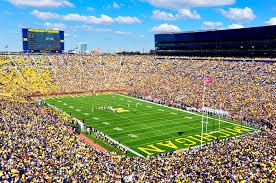
Attending home football games can be a huge part of the college experience. Camping out for tickets, tailgating for hours on game day, and cheering their teams on to victory in packed stadiums are cherished memories for countless college alumni. While you shouldn’t choose your college solely for its football team or stadium, if you think you would enjoy the atmosphere of big-time college sports, then it’s reasonable for the athletics environment at a school to play a role in your college decision.
In this article, I’ll provide you with a list of the 17 largest college football stadiums in the country. To give you some perspective on the size of these stadiums, the largest NFL stadium, Met Life Stadium, would only be number 16 on this list. These are not only the largest college football stadiums, but they're also the largest stadiums in the country.
The List of the Largest College Football Stadiums in the United States
#1: Michigan Stadium- University of Michigan Wolverines (107,601)
Facts
- Third largest stadium in the world behind Rungnado May Day Stadium in North Korea and Salt Lake Stadium in India
- Nicknamed "The Big House"
- The first game was played there on October 1, 1927 between Michigan and Ohio Wesleyan

#2: Beaver Stadium- Penn State University Nittany Lions (106,572)
Facts
- Built in 1960 in a horseshoe configuration seating 46,284
- Lights were added in 1984
- The stadium is named for James A. Beaver, a brigadier general for the Union Army in the Civil War who served as governor of Pennsylvania and president of the University's Board of Trustees

#3: Kyle Field- Texas A&M University Aggies (102,512)
Facts
- In 2015, the capacity was increased from 82,600
- Known as the "Home of the 12th Man"
- Largest stadium in the SEC

#4: Ohio Stadium- The Ohio State University Buckeyes (104,944)
Facts
- Built in 1922 for $1.3 million
- Refurbished in 2001 for slightly more than $194 million
- Known as "The Horseshoe" for its horseshoe configuration

#5: Neyland Stadium- University of Tennessee Volunteers (102,455)
Facts
- Named for General Robert Neyland, Tennessee football head coach from 1926-1952
- Opened in 1921 as Shields-Watkins Field
- More than 25 million people have attended football games at Neyland Stadium

#6: Tiger Stadium- Louisiana State University Tigers (102,321)
Facts
- The first game played at Tiger Stadium was in 1924 against Tulane
- The first night game was played in 1931 against Spring Hill
- Since the NCAA began compiling attendance records in 1957, LSU has averaged 77,647 spectators for its games in Tiger Stadium

#7: Bryant-Denny Stadium- University of Alabama Crimson Tide (101, 821)
Facts
- Denny Stadium opened in 1929 with a 55-0 victory over Mississippi College
- The stadium was renamed Bryant-Denny Stadium in 1976 in honor of Coach Paul Bryant
- Alabama has won more than 80% of its games in Bryant-Denny Stadium

#8: Darrell K Royal-Texas Memorial Stadium- University of Texas-Austin Longhorns (100,119)
Facts
- The original stadium was completed in 1924 and dedicated to the Texans who lost their lives in World War I
- In 1977, the stadium was rededicated to the memories of all alumni who had fought in all American wars
- The stadium was officially named after football coach Darrell K. Royal in 1996

#9: Los Angeles Memorial Coliseum- University of Southern California Trojans (93,067)
Facts
- The Coliseum is jointly owned by the State of California, Los Angeles County, and the City of Los Angeles
- The Coliseum has hosted two Olympic games, in 1932 and 1984
- The Los Angeles Dodgers of Major League Baseball played at the Coliseum from 1958-1962

#10: Sanford Stadium- University of Georgia Bulldogs (92,746)
Facts
- Named for Dr. SV Sanford, former president of the university
- It was opened in 1929
- It hosted the medal round of the 1996 Olympic men's and women's soccer competition

#11: Rose Bowl- UCLA Bruins (92,542)
Facts
- The Rose Bowl has hosted five Super Bowls
- It was built in 1922, but it wasn't home to UCLA's football games until 1982
- Site of the New Year's Tournament of Roses Football Game

#12: Memorial Stadium- University of Nebraska-Lincoln Cornhuskers (92,000)
Facts
- Every home football game has sold out since 1962
- Statues of former Nebraska coach Tom Osborne and former Nebraska quarterback Brook Berringer can be found outside the north side of the stadium
- When full, Memorial Stadium holds more people than any Nebraska city other than Omaha and Lincoln

#13: Ben Hill Griffin Stadium- University of Florida Gators (88,548)
Facts
- More commonly known as "The Swamp"
- "The Swamp" was coined by former coach Steve Spurrier in the 1990's
- The stadium was originally constructed in 1930

#14: Jordan-Hare Stadium- Auburn University Tigers (87,451)
Facts
- The stadium is named for Ralph "Shug" Jordan, Auburn's all-time winningest football coach, and Clifford Leroy Hare, a member of Auburn's first football team and president of the Southern Conference
- The turf is known as Pat Dye Field, named after former coach Pat Dye
- In 1939, the first game was played there to a 7-7 tie against the University of Florida

#15: Doak Campbell Stadium- Florida State University Seminoles (82,300)
Facts
- In 2004, the turf was named Bobby Bowden Field after legendary coach Bobby Bowden
- Doak Campbell Stadium opened on October 7,1950 when Florida State defeated Randolph-Macon 40-7.
- It's named after Doak S. Campbell, president of the university at the time of its construction

#16: Gaylord Family Oklahoma Memorial Stadium- University of Oklahoma Sooners (82,112)
Facts
- The stadium opened October 20,1923 against Washington University (Missouri)
- Also known as "The Palace on the Prairie"
- During the Great Depression and Dust Bowl, the stadium served as a dorm for young men attending the university

#17: Memorial Stadium- Clemson University Tigers (81,500)
Facts
- More commonly known as "Death Valley"
- Stadium opened on September 19, 1942 with a 32-13 victory over Presbyterian College
- Much of the construction of the stadium was done by scholarship athletes

What's Next?
Whether the athletics environment of the school is a factor in your college decision or not, I highly recommend that you review this article on how to choose a college.
If you subscribe to the philosophy that "bigger is better," check out this post on the biggest colleges in America. If you prefer to have smaller classes and be part of a close-knit community, learn about the best small colleges.











